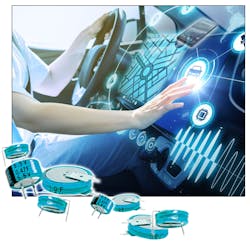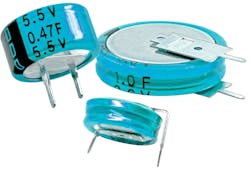Double-Layer Supercaps Provide Memory Backup in Circuits
New Yorker Electronics announced the release of the new EDC and EDS series of coin-cell style EDLC capacitors from Cornell Dubilier (CDE). With quick-response and recharge times, these devices offer higher power than batteries and greater energy than typical aluminum electrolytic capacitors—without degradation over millions of charge-discharge cycles, claims the company.
The new electric double-layer supercapacitors provide high capacitance values in a through-hole stacked coin type package. Three case configurations are available for horizontal, vertical, and radial-lead printed-circuit-board (PCB) mounting. The supercapacitors can also replace or extend battery life in on-board memory backup, says New Yorker Electronics.
The EDC and EDS series capacitors are ready to board-mount in applications such as real-time-clock (RTC) backup, power failure backup, battery assist, and in market segments like smart metering, HVAC controls, building automation, communication systems, appliances, instruments, and other microprocessor-based devices. Because of their high volumetric power density, they can be effective in reducing board size and weight. Either series can be used as a drop-in replacement for similar value capacitors recently discontinued by other manufacturers, says the company.
The CDE EDC series is rated at voltages up to 6.3 working voltage (WV) dc with an operating temperature range of -25 to +70°C. The EDS series is rated at 5.5 WV dc with an operating temperature range of -25 to +85°C. Both offer values from 0.047- to 1.5-F capacity. Primarily designed for integrated circuit voltage backup, the capacitors can also be used to deliver the initial power from batteries.
Features and Benefits:
- Long life
- High discharge current
- 70°C (EDC) or 85°C (EDS) operating temperature
Applications:
- On-board memory backup circuits
- Audio output circuits
- Energy/lighting
- Smart utility meters (AMR)
- Solar lights and energy storage
- Power conversion
- Internet of Things (IoT)—Energy harvesting/storage
- Industrial controls
- Telematics

